

 Vol. 39 (# 20) Year 2018. Page 30
Vol. 39 (# 20) Year 2018. Page 30
A. PUTILOV 1; I. BARANOVA 2; E.A. MYAKOTA 3
Received: 18/01/2018 • Approved: 15/02/2018
2. Implementation of various ISA forms: practical experience
3. Description of the Income-Share Agreement simulated model
ABSTRACT: This paper addresses an innovative higher education financing method - the Income Share Agreement - wherein the student receives the amount required for financing his or her education from the investor (an individual or an organization) in exchange for a guarantee to pay back a specific percentage of post-graduation income for a duration of time set forth in the agreement. The paper presents numerous instances of ISA’s practical implementation. An ISA simulation model was constructed on the basis of available practical results, allowing to model and optimize financial indicators. It was demonstrated that the most efficient method of ISA implementation under one contract is the successive investment in a three-year graduate program, followed by a one-year post-graduate program 3 or 4 years later. |
RESUMEN: Este documento aborda un método innovador de financiación de la educación superior, el Acuerdo de distribución de ingresos, en el que el alumno recibe la cantidad necesaria para financiar su educación del inversor (un individuo o una organización) a cambio de una garantía para devolver un porcentaje específico de ingresos después de la graduación por el tiempo establecido en el acuerdo. El documento presenta numerosos ejemplos de implementación práctica de ISA. Se construyó un modelo de simulación ISA sobre la base de los resultados prácticos disponibles, lo que permite modelar y optimizar los indicadores financieros. Se demostró que el método más eficiente de implementación de ISA bajo un contrato es la inversión sucesiva en un programa de postgrado de tres años, seguido por un programa de posgrado de un año 3 o 4 años después. |
Income-Share Agreement (ISA) is a financial instrument that stipulates the reception of a certain amount required for education financing by the student from the investor (individual or organization), in exchange for a guarantee to pay back a pre-determined percentage of his or her post-graduation earnings for the term set forth in the agreement.
A recent heightened interest in implementing ISAs is determined by the urgency of attracting private capital to the sphere of higher education financing. ISA is considered an alternative to traditional education loans.
The essential aspect that distinguishes an ISA from a bank loan is the lack of obligations on repayment of funds if the student’s post-graduation income is below threshold set forth in the agreement.
This fact is particularly important for students from low-income families. Loan risk assessment often leads prospective students to select a lower-priced higher education institution. Thus, the students do not realize their full intellectual potential, and the society is short-changed on professionals in various fields. The ISA system allows the student to stop worrying and continually calculating his or her debt to the creditor. If his or her school grades are high enough for a top-level university, this opportunity won’t be missed.
The non-repayment of education loans is also a serious federal-level problem. Notably, the default level on Federal Student Loans in the United States constitutes an average of 11.5%, reaching 40% for certain educational institutions (Douglas-Gabriel, 2017). The total amount of education loan debt is continuously growing, and now amounts to over USD 1 trillion (Matthews, 2013).
The greatest risks in the ISA system are born by the investors: they need to select the “objects” of investment, assist them throughout the education process, actively facilitate their employment and career advancement. In case of success, the investor may hit a jackpot and receive a ten-fold, or even greater, return.
The main proponent of ISA in the United States is Florida Senator Marco Rubio, who believes that the essential reason for the slow introduction of ISA into practice is the lack of legislative acts that regulate the relations between the investor and the student, and guarantee the investor the protection of his investment, while assuring the recipient’s clear understanding of the level of his or her responsibility and possible consequences in a negative case scenario.
A bill was introduced in April 2014 by Rubio-Petri, entitled the Investing in Student Success Act, whose objective is to make student loan debt more manageable via the use of Income ISAs (Marco Rubio, 2014).
Risks linked to the lack of ISA legislative regulation, as well as those connected to the numerous factors affecting the end result, have led to the emergence of various derivatives of ISA instruments. The variety of ISA implementation options induced the demand for simple and manageable mathematical models for assessing various financing methods.
The simulated ISA model elaborated in this paper provides its participants with an opportunity to assess financing options, including payment terms, projected post-graduation income, the repaid percentage of income, the project’s NPV.
The ISA concept was originally formulated by Milton Friedman in his work "The Role of Government in Education" (Friedman, 1955). In particular, M. Friedman gave the following definition to the ISA financial structure:
“The counterpart for education would be to "buy" a share in an individual's earning prospects: to advance him the funds needed to finance his training on condition that he agree to pay the lender a specified fraction of his future earnings”.
It’s worth noting that there was an institutionalized Communist party nomenclatura, or elite, in the 1950s USSR. Its members studied at the Higher Party School, the Institute for Advanced Training, attended lectures at the “Knowledge” society, participated in various conferences and seminars. All of these events were paid for by the Communist party. In turn, the party members paid dues in the amount of 2% of their income. In a certain way, the structure of the Communist party elite can be considered a prototype of the modern ISA financial system.
Below is a discussion of various projects that are implementing an ISA model of education financing. Considering the objective of the subsequent construction of a simulated ISA model, the following numerical parameters are of the greatest interest in these instances: the volume of financing, the percentage paid back, the term of repayment, ROI, NPV, etc.
In the 1970s Yale University implemented the ISA model in its “Tuition Postponement Program” (Palacios, 2004). In accordance with the program, students agreed to repay 0.4% of their future income over the course of 35 years (Curran, 1973). This project’s distinctive feature was that its participants were split into several groups, and the loan was disbursed to the group as a whole. Therefore, debt repayment was possible under the following case scenarios: one could buy out one’s own debt at 150% of its face value, or the group could buy out the whole group’s debt at 150% of its face value.
This project had an experimental nature. The loan was unlikely a burdensome one for most of the students. In 10-15 years following graduation the professionals’ salaries increased almost two-fold as a result of inflation, and half a percent of income is not a psychologically significant amount. Nonetheless, the project was partly shut down, since many students had expressed dissatisfaction with the fact that their payments were greater than they would be under bank loan terms, while a number of students were not paying at all. The principal conclusion made as a result of this project was that a low interest rate and a long repayment term are initially appealing to both students and investors. But an overly long investment return term bears risks linked to the changes in the economic and socio-political environment.
The Lumni project implemented in Columbia became a classic example of ISA utilization in the education sphere. Major companies are the principal investors of the fund. As he answered the question regarding the reasons for large companies’ preference for financing individual students rather than investing in education, the fund’s executive director Filipe Vergara stated: “If you ask a big corporation to make a donation for college scholarships, they may give you money to help 10 students. But if you offer them a profitable investment in students’ education, they will pay for 100 or 200 students” (Oppenheimer, 2015)
Acting in this manner, the fund has achieved significant results in a short period of time. Lumni is currently financing the education of 7000 students in Chile, Columbia, Peru, Mexico, and the United States of America. The fund in planning to reach the milestone of 30 000 students. The main risk of the investment model of education financing is the non-return of investments (Palacios, et al., 2004). Lumni reviews each contract individually. Depending on a number of parameters, mainly on the major selected by the student, it determines the repayment percentage and term of the contract. Simulation modeling is one of the phases of the ISA approval process, wherein the agreement parameters are finalized. As a rule, it is concluded for a term that does not exceed 6 years.
In 2011 Nathan Popkins established Cumulus Funding, a company that specializes in disbursing ISA-loans (Stein, 2016).
N. Popkins claimed that the window of opportunity opens up for the ISA precisely during financial crises. During this time banks refuse loans to problem clients, preferring to extend credits to those who are not in any particular need of money to begin with. The company’s name is currently Align Income Share Funding. The company has concluded over 500 ISA in the amount of up to $12500 for a term of 2 to 5 years on the condition of a 10% deduction from income.
The project was initiated by Allan Hancock College in Santa Maria, California. It resembles the Lumni project in many ways, its main distinction being that it only covers the members of the local community. This is one of remarkable distinctions of the ISA system. In small remote towns where the local residents don’t have high incomes, the community assists young adults in obtaining a decent education. Perhaps, some of them will return to their hometowns after graduation, and contribute to the development of local business, education and management system. But even if they don’t, the repaid funds will allow the next generation of young people to receive a higher education. Per the rules of the fund, the deductions from future income amount to 5% if the total annual income is $18 000 or higher. The 13th Avenue system aims to provide assistance to first-generation immigrants and low-income students (Matthews, 2013). The term of repayment is discussed in advance and may vary.
In 2011 Professor Benjamin M. Left and Professor Heather Hughes from the American University Washington College of Law suggested student loan derivatives to enhance Income-Based Approaches. They introduced a new model of law-school financing which received the name of an income-based repayment swap (“IBR Swap”).
In accordance with the IBR Swap, the student receives a bank loan for higher education. Concurrently, he concludes an agreement with an investment institution, wherein the financial institution begins to repay the student’s debt to the bank. In turn, the student takes on an obligation to pay the financial institution 15% of his or her post-graduation income over the course of 10 years (Left and Hughes, 2016). If the student refuses to pay a part of his income to the financial institution, he will face the need to repay the loan to the bank, as well as repay the costs associated with maintaining his contract, as per the agreement with the financial institution. As reflected in the IBR Swap description, this education financing scheme lowers the investor’s risks considerably. First of all, the bank, rather than the investor pays for the entire cost of education. Secondly, the investor essentially repays to the bank the difference between the loan payment set by the bank and the amount of funds received from the student.
In 2016 Oregon Higher Education Coordinating Commission (“HECC”) had established a pilot ISA project (Harnisch, 2014). House Bill 2662 would have launched a program that allowed students to enjoy free college tuition in case they agreed to repay a share of their post-graduate income to the state (Marmaduke, 2015).
Project Pay It Forward (PIF) is a pioneering, sustainable strategy of education financing that enables students to attend college or university in Oregon tuition-free in return for a small, pre-set percentage of the student’s future income, for a pre-determined amount of time (HECC, 2016). In accordance with the PIF program, 1000 students will receive financing for state college and university education. This project requires USD 4 to 6 million in annual investments. Following graduation, the students will pay back between 0.75% and 1% of their income over the course of 10 years. Many of the parameters and conditions of the investment have not been finalized yet, for example, it is proposed that some of the students may be selected for the PIF program via a lottery. Supposedly, the maximum amount of investment in the amount of USD 20 million will be required in four years. The full repayment of investments will be attained in approximately twenty years. Subsequently, the project will continue to yield an annual income of USD 3 to 8 million to the investor.
The Back a Boiler project set off at Purdue University in 2016. This project is another instance of a classic ISA model: students receive financing in return for the agreement to share a portion of his or her post-graduate income. In the first year of the project’s existence approximately 160 students have received financing. The total amount of investments in the project constituted
just over $2 million.
“Our goal for the first year was to offer Back a Boiler to students who planned to borrow through private and Parent Plus loans in addition to any public-subsidized loans,” said Brian Edelman, chief operating officer of the Purdue Research Foundation, who worked closely with Purdue’s Division of Financial Aid to create the program. (2017). The Back a Boiler project found support in the US Congress.
In particular, Rep. Luke Messer’s (IN-06) prepared a draft of the Investing in Student Achievement (ISA) Act of 2017, which was inspired by Purdue University’s ‘Back a Boiler’ program, the first major national income share agreement program.
This law will allow to alleviate a certain ambiguity in taxation issues in regard to ISA contracts, and to protect consumers, setting maximum repayment amounts (Messer, 2017).
One of the distinctive features of the Back a Boiler project is its close interaction with the university’s philanthropic programs. For example, there is additional financing provided to the Back a Boiler participants through the Pave the Way project. This project’s fund is replenished by voluntary contributions from Back a Boiler participants. The Pave the Way program plays a significant ethical role in shaping a feeling of responsibility and gratitude in the project participants for the vested confidence and financial assistance.
In their papers the authors of the IBR Swap project place special emphasis on the problem of monitoring the student’s post-graduate income. If this issue does exist, the Pave the Way project may be one of the solutions.
Numerous experts name Pave, Upstarts and SoFi among the startups that began working with ISA. However, some time ago they have temporarily suspended the ISA proposal and switched to refinancing (Bond, 2013). The reason for this paradigm change was a record low key interest rate, which made it profitable to provide loans at a lower interest rate than that of the federal education loans. While the interest rate on federal loans may vary between 3.75% and 6.31%, SoFi, for example, offers an education loan at a 2.5% interest rate. It is noteworthy that all of the companies have included a clause that’s essential to the project’s success, which they inherited from ISA: the payments are temporarily suspended if the student loses his or her job, meanwhile, the company will exert every effort to assist in finding employment for the borrower. According to the founder and the CEO of Upstarts Dave Girouard, the investors today still consider ISA too risky an investment instrument. During the term of its cooperation with ISA his company had built up a loan portfolio amounting to USD 3 million, while in the last three years of online loan provision at a fixed low interest rate the total amount of loans grew to USD 400 million. This case scenario with education loans is likely to be preserved for as long as the key interest rate remains extremely low. (Baranova, 2016)
Most of the abovementioned projects utilize the integrated ISA model. This financial model contains a number of variable parameters that affect the end result of investment.
These variables include:
Cost and term of education, percentage of deduction from post-graduation income, term of repayment, predicted income and its annual growth.
In order to optimize these parameters, a simulated model of the Income-Share Agreement financial instrument was created. Below is the description of the model and the discussion of the results of modeling.
The simulation model was developed with the utilization of IThink software manufactured by isee systems (Richmont, 2004). The diagram of the ISA model financial flows is displayed in Figure 1. All of the model’s parameters are variable, and their initial values are entered via the program interface. (Figure 2). The program may be controlled via the Internet.
https://exchange.iseesystems.com/public/irina-baranova/income-share-agreement-postgraduate
Fig.1
Diagram of financial flows within the ISA model.
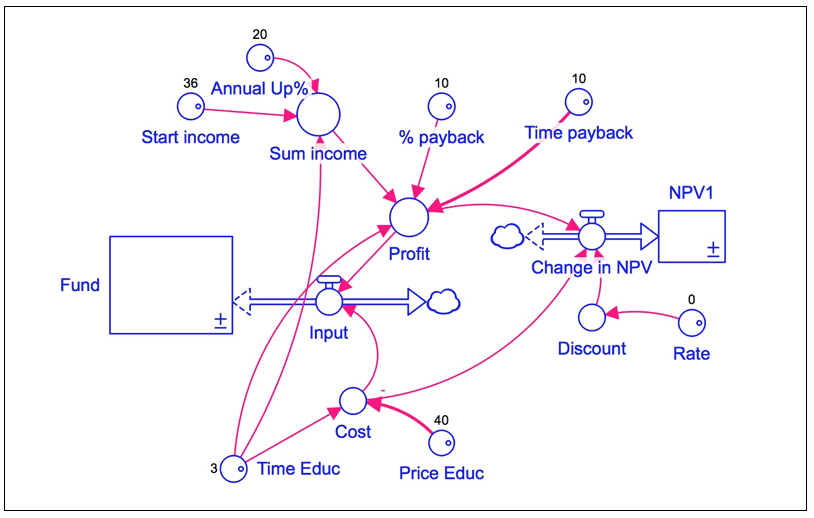
The elaborated model is a universal one. Any user, whether a student or an investor, may enter their own initial data and receive various solutions. The initial modeling data for this research (cost and term of education) were taken from the University of Oxford website (www.ox.ac.uk).
Two forms of education were selected for modeling – basic three-year graduate program, and a one-year post-graduate program for advancing one’s qualifications to an expert level.
The initial data on the income of the professionals with a university education was provided by the NGRS human resources agency in Moscow, Russia. The percentage and term of deduction were selected as an average value based on data obtained from literature. All calculations are made in British pound sterling.
The Net Present Value (NPV) parameter was used to the investment efficiency. NPV is profit amount calculated by subtracting the current cash outflow values (including initial cost) from the current values of cash inflows over a specific period of time (Daniel,2003).
NPV was calculated according to the following formula:
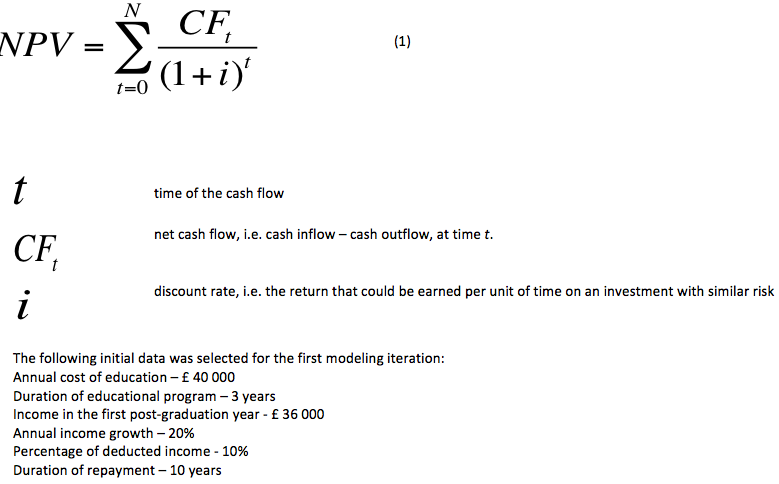
This initial data formed the foundation for comparative analysis in subsequent digital experiments.
Fig.2
Simulation model management interface.
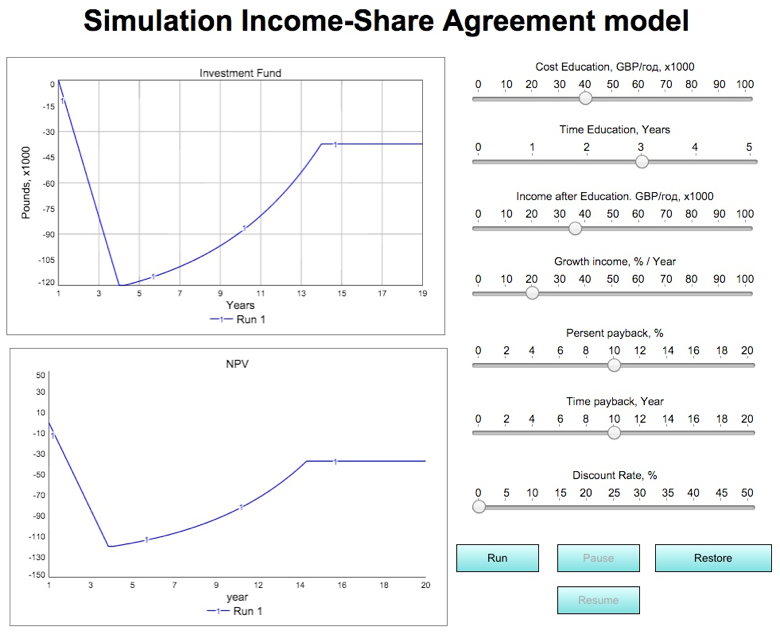
Initial data used for modeling financial flows in experiment No.1 is presented in Table 1. The following parameters are shared by all three iterations: percentage of income deducted - 10%, the term of repayment – 15 years and the discount rate – 10%.
Table 1
Initial data used for modeling financial flows in experiment No.1
|
Investment |
Time Education |
Income |
Growth of Income |
|
Pounds/Year |
Year |
Pounds/Year |
% |
Run 1 |
40 000 |
3 |
36 000 |
10 |
Run 2 |
50 000 |
2 |
50 000 |
20 |
Run 3 |
60 000 |
1 |
70 000 |
30 |
The results of modeling are presented in Fig.3 diagram.
Fig.3
NPV for various educational program durations.
(Run 1- 3 years, Run 2 – 2 years, Run 3 – 1 year)
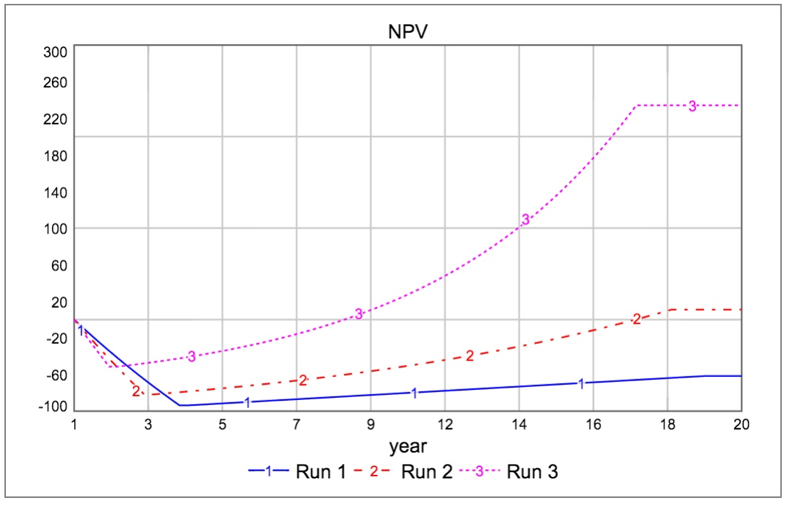
The simulation results demonstrate that the NPV of three-year education is less than zero when the discount rate is equal to 10%. Two-year education programs negligibly exceed the zero value. The greatest impact, despite the greater annual amount of investment, is produced by investing in one-year education programs. It is widely thought that using NPV for comparing projects with different terms and investment volumes is not quite appropriate. The UNIDO method, wherein the Indicator of the speed of specific increment in value (IS) is proposed as the synthetic efficiency indicator, should be used for more precise analysis of projects’ investment appeal. Graphs, in which the main trends and values for each of the specific time periods were determined, were used for comparison.
The modeling of financial flows was conducted on the basis of default initial data quoted above. The first curve (Run 1) corresponds to a 10-year repayment term. NPV graphs with increments of 1 year are subsequently displayed. In all of the diagrams (with the exception of Run 6) the discount rate was established at 10%. In Run 6 the discount rate was equal to 5%. The results of modeling are presented in Fig.4. Analysis of the obtained data allows to make a conclusion regarding the fact that the ISA model for three-year education becomes efficient (NPV>0) in cases when the repayment term is extended to 15 years, and the discount rate equals 5%.
Fig. 4
NPV dependence on the payback term. Run 1 – 10 years, Run 2 -11 years,
Run 3- 12 years, Run 4 – 13 years, Run 5 – 15 years (10%), Run 6 – 15 years (5%).
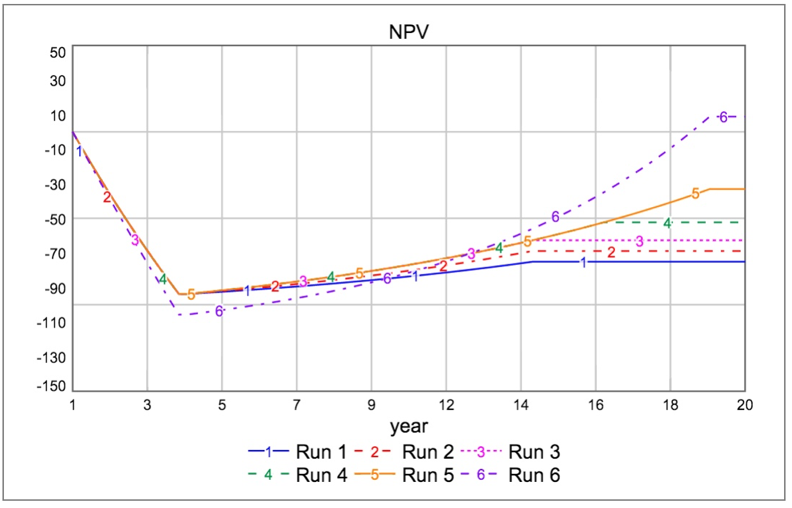
It is apparent that the attainment of a positive NPV value depends on the selected discount rate. The results of modeling NPV dependence on the discount rate for one-year educational programs are presented in Fig.2.
Table 2
Net present value of investing in one-year educational programs
Discount Rate |
Time payback, Years |
||||||||||
|
1 |
2 |
3 |
4 |
5 |
6 |
7 |
8 |
9 |
10 |
11 |
5 |
-37,0 |
-32,8 |
-26,5 |
-19,3 |
-11,1 |
-1,7 |
9,0 |
21,3 |
35,3 |
51,3 |
69,6 |
10 |
-34,3 |
-30,6 |
-25,3 |
-19,5 |
-13,2 |
-6,3 |
1,2 |
9,4 |
18,4 |
28,1 |
38,8 |
15 |
31,9 |
-28,6 |
-24,1 |
-19,4 |
-14,5 |
-9,4 |
-4,0 |
1,6 |
7,4 |
13,5 |
19,8 |
20 |
29,8 |
-26,9 |
-23,0 |
-19,1 |
-15,3 |
-11,4 |
-7,5 |
-3,7 |
0,2 |
4,1 |
8,0 |
25 |
27,9 |
-25,3 |
-22,0 |
-18,8 |
-15,7 |
-12,7 |
-9,9 |
-7,2 |
-4,6 |
-2,0 |
0,4 |
30 |
26,2 |
-23,9 |
-21,0 |
-18,3 |
-15,8 |
-13,5 |
-11,4 |
-9,5 |
-7,7 |
-6,1 |
-4,5 |
The results of modeling demonstrate that investing according to the ISA model may prove efficient even when the discount rate equals 25%, wherein the positive NPV value is attained 10 years later.
As it was demonstrated in experiments No. 1 and 2, investing in one-year programs is highly efficient, while for three-year programs the NPV assumes a positive value only if the term of repayment is extended to over 15 years. It is equally important for businesses to obtain specialists who have completed the basic three-year training, and professionals who have completed the subsequent one-year program. In view of this, an idea emerged to conduct experiments to model the efficiency of investments for the consecutive 3+1 educational programs. The results of such modeling are presented in Fig.5.
The first graph (Run 1) corresponds to a standalone three-year educational program. Run 2 – to a three-year program followed by a nine-year break, and then a one-year program (3+9+1). Run 3 – corresponds to a 3+6+1 scheme, and Run 4 – to a 3+3+1.
Fig.5
NPV’s dependence on the interval of time between completing
a three-year program and a one-year program.
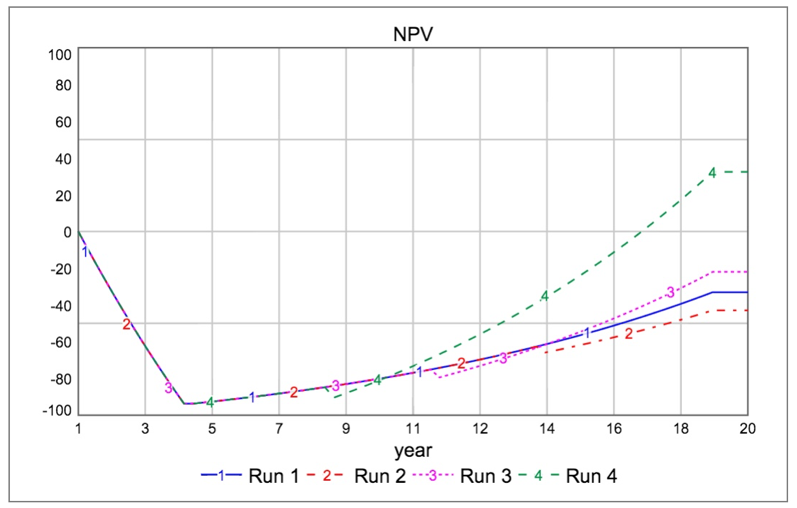
The results of modeling demonstrate that implementing the financial ISA model is efficient if the period of time between the three-year and one-year program does not exceed 3-4 years. The NPV value for the 3+9+1 investment scheme is even lower than for the basic three-year educational program. Undoubtedly, the conclusions made are relevant exclusively for ISA model utilization for financing the students’ higher education under various programs.
The Income-Share Agreement financial model has been gaining increasingly greater popularity in the recent years. Tens of thousands of students in Latin America and the USA gained an opportunity to study at colleges and universities owing to this innovative education financing instrument. The majority of ISA contracts is concluded individually, due to the fact that financial results depend on a great number of factors: the term and cost of education, the selected study major and post-graduate earning potential, bank interest rate at the time of agreement conclusion and the investment fund’s own discount rate. The elaborated simulation model allows to emulate financial indicators online, compare them and select the result that’s most acceptable to all of the participants.
In the course of the conducted digital experiments it was determined that investing consecutively in a three-year graduate program, and then in a postgraduate one-year program after a 3 to 4-year hiatus, has proven the most efficient under one contract.
Baranova I., Putilov A. Investment in human capital is a revolution of education funding. Journal of Modern Competition, 2016, vol. 10, no. 4 (58), pp. 90–95 (in Russian, abstr. in English)
Belkin D. (2015). More College Students Selling Stock—in Themselves. The Wall Street Journal, Aug. 5, 2015
Bond L. (2013). Overseas students are lent a financial helping hand. Financial Times, www.ft.com
Douglas-Gabriel, D. (2017) The number of people defaulting on federal student loans is climbing. The Washington post. https://www.washingtonpost.com/news/grade-point/wp/2017/09/28/the-number-of-people-defaulting-on-federal-student-loans-is-climbing/?utm_term=.7706f711cdd1#comments
Curran W, (1973) Yale’s Tuition Postponement Option, 2 J.L. & EDUC. 283 .
Matthews L. (2013). Student Loan Debt Crisis: A New Nonprofit 13th Avenue Wants An America Without College Loans. International Business Times. http://www.ibtimes.com/student-loan-debt-crisis-new-nonprofit-13th-avenue-wants-america-without-college-loans-1366729
Fadel K. (2017) Quran & Capitalism: The Compliance of Income Share Agreements with Shari'ah. Rollins College http://scholarship.rollins.edu/cgi/viewcontent.cgi?article=1052&context=honors
Friedman M. The Role of Government in Education, 1955
Harnisch T.L., (2014) The “Pay It Forward” College Financing Concept: A Pathway to the Privatization of Public Higher Education, POL’Y MATTERS, July 2014, http://www.aascu.org/
H.R. 4436, 113th Cong. (2014).
Left B.M., Hughes H. (2016) Student Loan Derivatives: Improving on Income-Based Approaches to Financing Law School, 61 Villanova Law Review 99 (2016)
Marmaduke J. (2015) 'Pay It Forward' tuition program needs more planning, House panel says. http://www.oregonlive.com/politics/index.ssf/2015/06/pay_it_forward_tuition_program.html
Messer L. (2017) Messer’s ‘Back a Boiler’ Legislation Gets Boost From Mitch Daniels, https://messer.house.gov/news/documentsingle.aspx?DocumentID=675
Oppenheimer A. (2015). Latin America’s big education innovation, Miami Herald, april 2015
Palacios M. (2004) Investing in human capital: a capital markets approach to student funding. Cambridge, UK ; New York : Cambridge University Press
Palacios M., DeSorrento T., Kelly A. (2014) Investing in Value, Sharing Risk; Financing Higher Education Through Income Share Agreements". American Enterprise Institute Series on Reinventing Financial Aid, 2014
Palacios, M and Kelly, A.P. A Better Way to Finance That College Degree. The Wall Street Journal, April 2014, https://www.wsj.com/articles/miguel-palacios-and-andrew-kelly-a-better-way-to-finance-that-college-degree-1397428704
Pay It Worward (2016). HECC. http://www.oregon.gov/highered/plan-pay-for-college/Pages/pay.aspx
Purdue expands income share agreement program to include more students, summer session (2017) https://www.purdue.edu/newsroom/releases/2017/Q2/purdue-expands-income-share-agreement-program-to-include-more-students,-summer-session.html
Richmont B. (2004) Introduction in systems thinking. Isee systems inc., 2004
Stein M.A. (2016) Students Look to Loan Alternatives to Simplify Process and Ease Burden. The New York Times. https://www.nytimes.com/2016/06/23/education/students-look-to-loan-alternatives-to-simplify-process-and-ease-burden.html
1. National Research Nuclear University «MEPHI», Moscow, Russia
2. National Research Nuclear University «MEPHI», Moscow, Russia . Email: irina.baranova@ngrs.com
3. Business School, National Research Nuclear University «MEPHI», Moscow, Russia